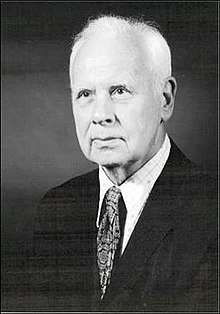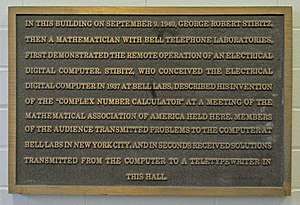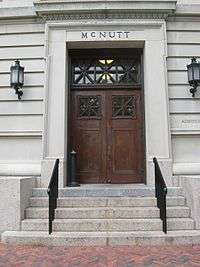George Stibitz
George Robert Stibitz (April 30, 1904[1] – January 31, 1995)[2] was a Bell Labs researcher internationally recognized as one of the fathers of the modern first digital computer. He was known for his work in the 1930s and 1940s on the realization of Boolean logic digital circuits using electromechanical relays as the switching element.
George Stibitz | |
|---|---|
 | |
| Born | April 30, 1904 York, Pennsylvania, U.S. |
| Died | January 31, 1995 (aged 90) Hanover, New Hampshire, U.S. |
| Alma mater | Cornell University Union College Denison University |
| Awards | Harry H. Goode Memorial Award (1965) IEEE Emanuel R. Piore Award (1977) |
Stibitz was born in York, Pennsylvania. He received his bachelor's degree from Denison University in Granville, Ohio, his master's degree from Union College in 1927, and his Ph.D. in mathematical physics in 1930 from Cornell University.
Computer


In November 1937, George Stibitz, then working at Bell Labs (1930–1941),[3] completed a relay-based calculator he later dubbed the "Model K" (for "kitchen table", on which he had assembled it), which calculated using binary addition.[4] Replicas of the "Model K" now reside in the Computer History Museum, the Smithsonian Institution, the William Howard Doane Library at Denison University and the American Computer Museum in Bozeman, Montana, where the George R. Stibitz Computer and Communications Pioneer Awards are granted.
Bell Labs subsequently authorized a full research program in late 1938 with Stibitz at the helm. Their Complex Number Computer, completed in November 1939 and put into operation in 1940, was able to do calculations on complex numbers.[5] In a demonstration to the American Mathematical Society conference at Dartmouth College in September 1940, Stibitz used a modified teletype to send commands to the Complex Number Computer in New York over telegraph lines.[6][7] It was the first computing machine ever used remotely.[8] (See the commemorative plaque and the hall where this event took place in the photos below.)
Wartime activities and subsequent Bell Labs computers
After the United States entered World War II in December 1941, Bell Labs became active in developing fire-control devices for the U.S. military. The Labs' most famous invention was the M-9 Gun Director,[9] an ingenious analog device that directed anti-aircraft fire with uncanny accuracy.[10] Stibitz moved to the National Defense Research Committee, an advisory body for the government, but he kept close ties with Bell Labs. For the next several years (1941–1945),[3] with his guidance, the Labs developed relay computers of ever-increasing sophistication. The first of them was used to test the M-9 Gun Director. Later models had more sophisticated capabilities. They had specialized names, but later on, Bell Labs renamed them "Model II", "Model III", etc., and the Complex Number Computer was renamed the "Model I". All used telephone relays for logic, and paper tape for sequencing and control. The "Model V", was completed in 1946 and was a fully programmable, general-purpose computer, although its relay technology made it slower than the all-electronic computers then under development.[11]
After the war, in 1945, Stibitz didn't returns to Bell Labs, but instead went into private consulting work.[12][3]
Origin of the term "digital"
In April 1942, Stibitz attended a meeting of a division of the Office of Scientific Research and Development (OSRD), charged with evaluating various proposals for fire-control devices to be used against Axis forces during World War II. Stibitz noted that the proposals fell into two broad categories: "analog" and "pulse". In a memo written after the meeting, he suggested that the term "digital" be used in place of "pulse", as he felt the latter term was insufficiently descriptive of the nature of the processes involved. The word "digit" at the time had two common meanings: the ten fingers of one's hands, and the numbers 0 through 9. The adjective "digital" was also in use, although it was not as common. For example, among physicians, a "digital" examination referred to the use of a doctor's finger to palpate part of the body. Stibitz's memorandum was the first known use of the term "digital" to refer to calculating machinery.[13]
Awards
- Harry H. Goode Memorial Award in 1965 (together with Konrad Zuse)
- IEEE Emanuel R. Piore Award, 1977
- IEEE's Computer Pioneer Award, 1982
- election to the National Academy of Engineering, 1981
- election to the National Inventors Hall of Fame, 1985
Stibitz held 38 patents, in addition to those he earned at Bell Labs. He became a member of the faculty at Dartmouth College in 1964 to build bridges between the fields of computing and medicine, and retired from research in 1983.
Computer art
In his later years, Stibitz "turned to non-verbal uses of the computer". Specifically, he used a Commodore-Amiga to create computer art. In a 1990 letter, written to the department chair of the Mathematics and Computer Science department of Denison University he said:
I have turned to non-verbal uses of the computer, and have made a display of computer "art". The quotes are obligatory, for the result of my efforts is not to create important art but to show that this activity is fun, much as the creation of computers was fifty years ago.
The Mathematics and Computer Science department at Denison University has enlarged and displayed some of his artwork.
Publications
- Stibitz, George; Larrivee, Jules A. (1957). Mathematics and Computers. New York: McGraw-Hill.
See also
- List of pioneers in computer science
- John Vincent Atanasoff
- Bell Labs
- Stibitz code (3-excess code)
Notes
- Henry S. Tropp, "Stibitz, George Robert," in Anthony Ralston and Edwin D. Reilly, eds., Encyclopedia of Computer Science, Third Edition (New York: van Nostrand Rheinhold, 1993), pp. 1284–1286. Some accounts give April 20 as his birth date, but the Tropp citation is the most authoritative.
- Saxon, Wolfgang. "Dr. George Stibitz, 90, Inventor Of First Digital Computer in '40". Retrieved 2018-09-07.
- "Computer Pioneers - George Robert Stibitz". history.computer.org.
- Ritchie, David (1986). The Computer Pioneers. New York: Simon and Schuster. p. 35. ISBN 067152397X.CS1 maint: ref=harv (link)
- Ritchie 1986, p. 38.
- Ritchie 1986, p. 39.
- Metropolis, Nicholas (2014-06-28). History of Computing in the Twentieth Century. Elsevier. p. 481. ISBN 9781483296685.
- Dalakov, Georgi. "Relay computers of George Stibitz". History of Computers: Hardware, Software, Internet. Retrieved 30 March 2015.
- "BLOW HOT-BLOW COLD - The M9 never failed". Bell Laboratories Record. XXIV (12): 454–456. December 1946.
- Eames, office of Charles and Ray, A Computer Perspective: Background to the Computer Age (Cambridge, MA: Harvard University Press 1973, 1990), p. 128
- Ceruzzi, Paul E. (1983). "4. Number, Please - Computers at Bell Labs". Reckoners: The Prehistory of the Digital Computer, from Relays to the Stored Program Concept, 1935-1945. Greenwood Publishing Group, Incorporated. ISBN 9780313233821.
- "The relay computers at Bell Labs : those were the machines, part 2". Datamation. The relay computers at Bell Labs : those were the machines, parts 1 and 2 | 102724647 | Computer History Museum. part 2: pp. 49. May 1967.
After the time that the designs for Model V were completed I resigned from Bell Labs to go into independent consulting work.
- Bernard O. Williams, "Computing with Electricity, 1935–1945," PhD Dissertation, University of Kansas, 1984 (University Microfilms International, 1987), p. 310
References
- Melina Hill, Valley News Correspondent, A Tinkerer Gets a Place in History, Valley News West Lebanon NH, Thursday March 31, 1983, page 13.
- Brian Randall, ed. The Origins of Digital Computers: Selected Papers (Berlin, Heidelberg, New York: Springer-Verlag, 1975), pp. 237–286.
- Andrew Hodges (1983), Alan Turing: The Enigma, Simon and Schuster, New York, ISBN 0-671-49207-1. Stibitz is mentioned briefly on pages 299 and 326. Hodges refers to Stibitz's machine as one of two "big relay calculators" (Howard H. Aiken's being the other one, p. 326).
- "The second American project [Aiken's being the first] was underway at Bell Laboratories. Here the engineer G. Stibitz had first only thought of designing relay machines to perform decimal arithmetic with complex numbers, but after the outbreak of war had incorporated the facility to carry out a fixed sequence of arithmetical operations. His 'Model III' [sic] was under way in the New York building at the time of Alan Turing's stay there, but it had not drawn his attention." (p. 299)
- Stibitz's work with binary addition has a peculiar (i.e. apparently simultaneous) overlap with some experimenting Alan Turing did in 1937 while a PhD student at Princeton. The following is according to a Dr. Malcolm McPhail "who became involved in a sideline that Alan took up" (p. 137); Turing built his own relays and "actually designed an electric multiplier and built the first three or four stages to see if it could be made to work" (p. 138). It is unknown whether Stibitz and/or McPhail had any influence on this work of Turing's; McPhail's implication is that Turing's "[alarm]about a possible war with Germany" (p. 138) caused him to become interested in cryptanalysis, and this interest led to discussions with McPhail, and these discussions led to the relay-multiplier experiments (the pertinent part of McPhail's letter to Hodges is quoted in Hodges p. 138).
- Ritchie, David (1986). "George Stibitz and the Bell Computers". The Computer Pioneers. New York: Simon and Schuster. pp. 33–52. ISBN 067152397X.
- Smiley, Jane, The Man Who Invented the Computer: The Biography of John Atanasoff, Digital Pioneer, Random House Digital, Inc., 2010. ISBN 978-0-385-52713-2.
External links
Patents
- Stibitz, George Robert (1954-02-09) [1941-04-19]. "Complex Computer". Patent US2668661A. Retrieved 2020-05-24. (102 pages)
Other
- Obituary by Kip Crosby of the Computing History Association of California
- George R. Stibitz website at Denison University
- Home of the George R. Stibitz Computer and Communications Pioneer Awards
- Biography of Stibitz on the Pioneers website – By Kerry Redshaw, Brisbane, Australia
- Relay computers of George Stibitz (Detailed descriptions)
- Reckoners: the Prehistory of the Digital Computer, from Relays to the Stored Program Concept, 1935–1945 (Westport CT: Greenwood Press 1983), Chapter 4 (Detailed description and history)
- "The relay computers at Bell Labs : those were the machines, parts 1 and 2 | 102724647 | Computer History Museum". www.computerhistory.org. By Stibitz, George R. as told to mrs. Loveday, Evelyn. Retrieved 2017-10-11.CS1 maint: others (link)
- The Papers of George Stibitz at Dartmouth College Library